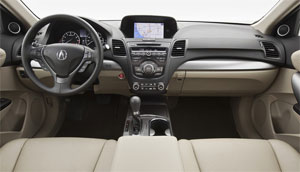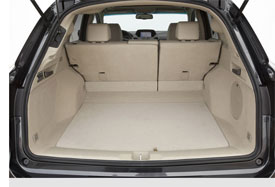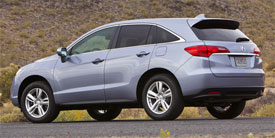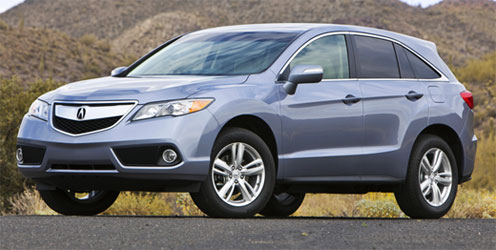2013 Acura RDX
The 2007 Acura RDX was hailed as the “urban running” back of compact crossovers. With turbo-4 power and super-handling all-wheel-drive it looked primed to blast through the competition. But, as it turns out, most compact luxury crossover pretenders aren’t looking for overboard performance; they just want room for their stuff, a few high end features to brag about, and enough traction for the occasional snow day. So, let’s see if the re-purposed Acura RDX does any better with this new mission.
Originally developed for young, hot-shot couples who were looking for a jazzy luxury crossover to make quick getaways out of the city, the 2013 Acura RDX has been redesigned more for the “been-there done-that” crowd, who want refinement and all-weather security in a compact but versatile package. And we can certainly feel that the new RDX is more refined. The MacPherson strut front suspension and trailing arm multi-link rear have been re-engineered, now with an emphasis more on ride comfort rather than handling performance.
Still, new Amplitude Reactive dampers feature an integrated rebound spring that helps maintain most of the previous models cornering capabilities. Power too takes a step upscale by substituting a corporate single-cam 3.5-liter V6. Horsepower is up 33 over the previous Turbo-4 to 273, and torque rates 251 lb-ft. The familiar six includes Variable Cylinder Management while the automatic transmission gains a sixth gear. Both gelling to make Government Fuel Economy Ratings actually better than the 4-cylinder at 19-City, 27-Highway, and 22-Combined for our all-wheel-drive model. We averaged an impressive 26.1 miles-per-gallon of Premium fuel in mixed driving. The Energy Impact Score is also much improved burning through 15.0-barrels of oil per year while emitting 6.7-tons of CO2.
 The all-wheel-drive system itself is less refined however. Gone is Acura’s torque shifting super-handling all-wheel-drive where up to 70 percent of power could switch to the rear wheels. The new RDX uses the Honda CR-V’s Intelligent Control on-demand system. So, while you won’t get much help in switchbacks, up to half the power can find its way to the back for able traction in slush and snow.
The all-wheel-drive system itself is less refined however. Gone is Acura’s torque shifting super-handling all-wheel-drive where up to 70 percent of power could switch to the rear wheels. The new RDX uses the Honda CR-V’s Intelligent Control on-demand system. So, while you won’t get much help in switchbacks, up to half the power can find its way to the back for able traction in slush and snow.
Refinement continues inside as the new cockpit has a genuine premium feel, trading a sporty edge for the more typical blend of Acura high-tech modern luxury. The leather upholstery looks both inviting and durable. But just when you start appreciating new features like standard 10-way power driver’s seat with heat, and push-button start; you also begin noticing cost cutting measures like only 4-way power for the front passenger and getting GPS navigation requires adding a costly Tech. package.
The NAV system is the typical Acura setup, and while we like the position of the central controller, we find that many times it just takes too many click-throughs to get to what you want. With just about everyone else going touch-screen why can’t Acura? Still, it’s hard to consider the RDX an entry-level model, as it is clearly a big step up over Acura’s other entry-level offering, the ILX sedan.
 It’s also hard to pigeonhole the RDX as a compact crossover either, as it offers interior room and an overall feel that’s more mid-size. That’s despite a small towing capacity of just 1,500-pounds. The rear seat is roomy for its size, however, and seat backs fold easily with the pull of a lever, though not completely flat. Still, seat up cargo room is almost best in class at 26.1 cubic-ft, and 61.3 with them folded.
It’s also hard to pigeonhole the RDX as a compact crossover either, as it offers interior room and an overall feel that’s more mid-size. That’s despite a small towing capacity of just 1,500-pounds. The rear seat is roomy for its size, however, and seat backs fold easily with the pull of a lever, though not completely flat. Still, seat up cargo room is almost best in class at 26.1 cubic-ft, and 61.3 with them folded.
If we have one complaint it’s that the new RDX doesn’t really seem to have a sparkling personality. It looks very nice, inside and out, especially with its more subdued shield grille; but a bit sterile overall, and perhaps now too similar to a lot of other compact crossovers including Honda’s own CR-V.
At our test track, the RDX’s electric-assist power steering felt great, and diving through the cones was easier than we were expecting given the absence of super-handling all-wheel-drive. Front end reaction is direct and turn-ins sharp, while body roll is moderate. Streaking down the quarter-mile, the RDX is smooth and quiet as it hits 95-miles per hour in 15.4-seconds. Sprints to 60 take just 7.0-seconds, thanks to a nice, firm launch and quick-building power. Panic stops from 60 averaged just 126-feet, with good pedal feel and consistency throughout our tests. So, maybe the RDX hasn’t lost all of its athletic pretense after all.
 But, as it is more refined and better equipped, its price has also moved a bit upscale. Base sticker jumps about 4 percent to $35,215. Adding all-wheel-drive is another $1,400, and going all in with the Tech. Package will take you to $40,315. The 2013 Acura RDX succeeds in its new mission of providing high tech luxury and four-season traction in a smaller but still ample sized package. And, it is truly a nice vehicle; it’s just no longer a stand out. The first RDX took a pretty unique approach. The new RDX is more of a consensus response. Still, that’s what small luxury crossover buyers seem to want, and the new RDX is a fine answer for their cravings.
But, as it is more refined and better equipped, its price has also moved a bit upscale. Base sticker jumps about 4 percent to $35,215. Adding all-wheel-drive is another $1,400, and going all in with the Tech. Package will take you to $40,315. The 2013 Acura RDX succeeds in its new mission of providing high tech luxury and four-season traction in a smaller but still ample sized package. And, it is truly a nice vehicle; it’s just no longer a stand out. The first RDX took a pretty unique approach. The new RDX is more of a consensus response. Still, that’s what small luxury crossover buyers seem to want, and the new RDX is a fine answer for their cravings.
Specifications
- Engine: 3.5-liter V6
- Horsepower: 273
- Torque: 251 lb-ft.
- 0-60 mph: 7.0 seconds
- 1/4 mile: 15.4 seconds @ 95 mph
- EPA: 19 mpg city/ 27 mpg highway
- Energy Impact: 15.0 barrels of oil/yr
- CO2 Emissions: 6.7 tons/yr
2024 Polestar 2
More Range And More Power For The Polestar 2
Volvo is well on their way to making the transition to an all-electric brand, but their sister-brand Polestar is already there. Now, we’ve spent lots of time in their all-wheel drive, five-door Polestar 2, having tested it in 2021, and a year later when a two-wheel drive version arrived. But, EV updates are coming quickly. So, let us be your guide for all that’s new with the Polestar 2.
While we are driving more EVs than ever, we’ve also been spending a lot of time recently circling back to ones we’ve previously tested. As in this new era of electrified vehicles, significant updates are arriving quickly, with R&D investments increasing and retrofitting them easier than ever. This is often done through software updates that can even be accomplished over the air. For 2024, the Polestar 2 has indeed gotten some software updates, but some physical ones as well.
Clearly aimed directly at Tesla’s Model 3 when it arrived; the Polestar 2’s build quality was vastly better, but range definitely came up short. So, addressing that was priority No. 1; and for ’24 the Polestar can travel up to 20% farther than before while consuming 9% less energy, and when it comes time to charge it back up, it can do that 34% faster too.
Range in the Single Motor version increases from a max of 270 to 320 miles thanks to a larger 82-kWh battery pack, and that solitary motor now powers the rear wheels, not the front wheels. It’s also bigger, coming in at 220 kW compared to the previous 170 kW front-wheel drive version, going from 231 to 299 horsepower.
Dual Motors keep the same 78-kWh battery, but still sees a boost from 260 to 276 miles and takes advantage of the larger rear motor for a new combined 310-kW output with 421 horsepower. Our test car has the added Performance Pack, which uses an additional 35 kW to deliver 455 horsepower and 546 lb-ft of torque, though max range drops to just 247 miles.
The new battery in rear-drive 2s will also charge faster, now accepting up to 205 kW for an 80% charge in 20 minutes; max for dual-motors stays at 155 kW, which puts an 80% charge at 34 minutes. Using 32 kWh of electricity per 100 miles, the Dual Motor earns a good efficiency rating.
The [Polestar] 2 has always been one of the most enjoyable EVs to drive, even more so now with that additional power coming from the rear motor.
Unfortunately, extremely cold temperatures kept us from seeing that increased range, as we were only on pace for about 194 miles in our test.
The 2 has always been one of the most enjoyable EVs to drive, even more so now with that additional power coming from the rear motor. And especially when equipped with the Performance Pack as it not only includes more power, but adds 20-inch forged wheels, upgraded brakes, and adjustable Ohlins Dual Flow Valve performance dampers. It greatly improves handling prowess without affecting ride quality, and is easily worth the $5,500 charge if you at all enjoy driving.
Even on a 20-degree track day there was plenty of grip through our handling course. No understeer or oversteer, and lots of feedback through the wheel. There was a nice, strong launch off the line that properly planted us firmly in the seat, and rocketed us to 60 in 4.5 seconds. Power delivery stayed pretty intense up until about 80 mph when there was a definite tapering off. Still, it was a 13.4-second quarter-mile at 102 mph; smooth, quiet, and stable the whole way.
When this car debuted, its Google-based infotainment setup was a novelty, but since then, more and more manufacturers are just “Googling it” so it doesn’t seem out of place at all. The wireless phone charger is easy to access, and there’s a great Harmon/Kardon sound system and panoramic sunroof to enhance the in-cabin experience. Exteriors have also been enhanced with a smooth grille insert and new wheel choices.
Hatchback practicality means 14.3 cu-ft of easy to access cargo space with split-folding seatbacks for longer items and expanding the space to 38.7 cu-ft. Plus, there’s even a sizeable storage bin up front under the hood.
Single Motor Polestar 2 pricing now starts at $51,300, with Dual Motors starting at $56,700; topping out at $64,400.
For a car manufacturer that hasn’t even been around for a decade yet, Polestar has kept itself busy, totally transforming their latest model in just a few years, making the 2024 Polestar 2 even more appealing. They are certainly off to a good start, and with a host of Polestars just over the horizon, including some all-important utility vehicles, this star will be shining even brighter.
Specifications
As Tested
- Motor Setup: Dual Motor
- Horsepower: 455
- 0-60 mph: 4.5 seconds
- EPA Range: 247 miles
- Efficiency : 32 kWh / 100 miles
- Battery Size: 78-kWh
- Torque: 546 lb-ft
- 1/4 Mile: 13.4 seconds at 102 mph
- MW Test Loop: ~ 194 miles
- Peak Charging Rate: 155 kW











































